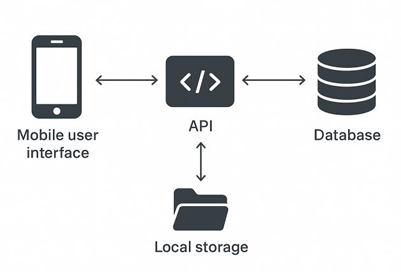Application Development with AI: a Case Study of Application x Development Progress
DOI:
https://doi.org/10.70393/6a6374616d.333236ARK:
https://n2t.net/ark:/40704/JCTAM.v2n6a02Disciplines:
Software TechnologySubjects:
Software EngineeringReferences:
9Keywords:
Artificial Intelligence, AI Tools, Mobile Application, Software Development Life-cycle, User InterfaceAbstract
Artificial intelligence (AI) has taken a leading position in various fields, especially in the development of information solutions. This article presents a case study of mobile application user interface redesign to highlight the benefits and improvements of integrating artificial intelligence. The study analyzes a typical mobile application, including technical and business details. The integration of artificial intelligence tools such as open source SolidGPT helps improve the development process in every aspect compared to the original version. The results show a lot of time saved and a lot of time reduced for similar activities. Additionally, the quality of the final product has improved, as evidenced by the reduction in crashes and issues found in similar time frames. The improvements achieved are very promising. The case study can be useful for technicians implementing AI tools and for decision-makers justifying investments in such integration.
References
[1] Hu, L., Wu, Q., & Qi, R. (2025). Empowering smart app development with SolidGPT: an edge–cloud hybrid AI agent framework. Advances in Engineering Innovation, 16(7), 86-92.
[2] Qi, R., & Hu, L. (2025). Stock Price Prediction of Apple Inc. Based on LSTM Model: An Application of Artificial Intelligence in Individual Stock Analysis. European Journal of AI, Computing & Informatics, 1(3), 1-9.
[3] Qi, R. (2025). Research on the Application of Robo-Advisory Systems in Personal Wealth Management: A Case Study of Middle-Class Households in the United States. Economics and Management Innovation, 2(4), 46-55.
[4] Qi, R. (2025). An Empirical Study on Credit Risk Assessment Using Machine Learning: Evidence from the Kaggle Credit Card Fraud Detection Dataset. Journal of Computer, Signal, and System Research, 2(5), 48-64.
[5] Qi, R. (2025). Loan Default Prediction and Feature Importance Analysis Based on the XGBoost Model. European Journal of Business, Economics & Management, 1(2), 141-149.
[6] Hu, L. (2025). Hybrid Edge-AI Framework for Intelligent Mobile Applications: Leveraging Large Language Models for On-device Contextual Assistance and Code-Aware Automation. Journal of Industrial Engineering and Applied Science, 3(3), 10-22.
[7] Hu, L. (2025). Topic Classification of Small Sample News Based on Prompt Engineering. Applied and Computational Engineering, 170, 101-107.
[8] Amugongo, L. M., Kriebitz, A., Boch, A., & Lütge, C. (2025). Operationalising AI ethics through the agile software development lifecycle: a case study of AI-enabled mobile health applications. AI and Ethics, 5(1), 227-244.
[9] John, M. M., Olsson, H. H., & Bosch, J. (2023). Towards an AI‐driven business development framework: A multi‐case study. Journal of Software: Evolution and Process, 35(6), e2432.

Downloads
Published
How to Cite
Issue
Section
ARK
License
Copyright (c) 2025 The author retains copyright and grants the journal the right of first publication.

This work is licensed under a Creative Commons Attribution 4.0 International License.


















